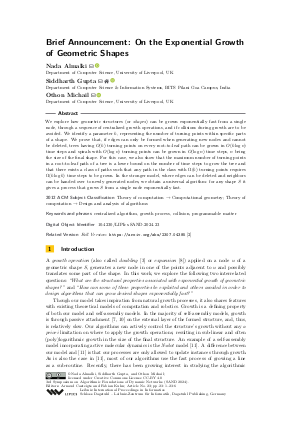Brief Announcement: On the Exponential Growth of Geometric Shapes
Authors
Nada Almalki  ,
Siddharth Gupta
,
Siddharth Gupta  ,
Othon Michail
,
Othon Michail 
-
Part of:
Volume:
3rd Symposium on Algorithmic Foundations of Dynamic Networks (SAND 2024)
Part of: Series: Leibniz International Proceedings in Informatics (LIPIcs)
Part of: Conference: Symposium on Algorithmic Foundations of Dynamic Networks (SAND) - License:
 Creative Commons Attribution 4.0 International license
Creative Commons Attribution 4.0 International license
- Publication Date: 2024-05-31
File

PDF
LIPIcs.SAND.2024.23.pdf
- Filesize: 0.52 MB
- 6 pages
Document Identifiers
Related Versions
- Full Version https://arxiv.org/abs/2307.04385
Subject Classification
ACM Subject Classification
- Theory of computation → Computational geometry
- Theory of computation → Design and analysis of algorithms
Keywords
- centralized algorithm
- growth process
- collision
- programmable matter
Metrics
- Access Statistics
-
Total Accesses (updated on a weekly basis)
0PDF Downloads0Metadata Views
Abstract
We explore how geometric structures (or shapes) can be grown exponentially fast from a single node, through a sequence of centralized growth operations, and if collisions during growth are to be avoided. We identify a parameter k, representing the number of turning points within specific parts of a shape. We prove that, if edges can only be formed when generating new nodes and cannot be deleted, trees having O(k) turning points on every root-to-leaf path can be grown in O(klog n) time steps and spirals with O(log n) turning points can be grown in O(log n) time steps, n being the size of the final shape. For this case, we also show that the maximum number of turning points in a root-to-leaf path of a tree is a lower bound on the number of time steps to grow the tree and that there exists a class of paths such that any path in the class with Ω(k) turning points requires Ω(klog k) time steps to be grown. In the stronger model, where edges can be deleted and neighbors can be handed over to newly generated nodes, we obtain a universal algorithm: for any shape S it gives a process that grows S from a single node exponentially fast.
Cite As Get BibTex
Nada Almalki, Siddharth Gupta, and Othon Michail. Brief Announcement: On the Exponential Growth of Geometric Shapes. In 3rd Symposium on Algorithmic Foundations of Dynamic Networks (SAND 2024). Leibniz International Proceedings in Informatics (LIPIcs), Volume 292, pp. 23:1-23:6, Schloss Dagstuhl – Leibniz-Zentrum für Informatik (2024)
https://doi.org/10.4230/LIPIcs.SAND.2024.23
BibTex
@InProceedings{almalki_et_al:LIPIcs.SAND.2024.23,
author = {Almalki, Nada and Gupta, Siddharth and Michail, Othon},
title = {{Brief Announcement: On the Exponential Growth of Geometric Shapes}},
booktitle = {3rd Symposium on Algorithmic Foundations of Dynamic Networks (SAND 2024)},
pages = {23:1--23:6},
series = {Leibniz International Proceedings in Informatics (LIPIcs)},
ISBN = {978-3-95977-315-7},
ISSN = {1868-8969},
year = {2024},
volume = {292},
editor = {Casteigts, Arnaud and Kuhn, Fabian},
publisher = {Schloss Dagstuhl -- Leibniz-Zentrum f{\"u}r Informatik},
address = {Dagstuhl, Germany},
URL = {https://drops.dagstuhl.de/entities/document/10.4230/LIPIcs.SAND.2024.23},
URN = {urn:nbn:de:0030-drops-199015},
doi = {10.4230/LIPIcs.SAND.2024.23},
annote = {Keywords: centralized algorithm, growth process, collision, programmable matter}
}
Author Details
References
-
Hugo A. Akitaya, Esther M. Arkin, Mirela Damian, Erik D. Demaine, Vida Dujmović, Robin Flatland, Matias Korman, Belen Palop, Irene Parada, André van Renssen, et al. Universal reconfiguration of facet-connected modular robots by pivots: the O(1) musketeers. Algorithmica, 83(5):1316-1351, 2021.

- Nada Almalki, Siddharth Gupta, and Othon Michail. On the exponential growth of geometric shapes, 2024. URL: https://arxiv.org/abs/2307.04385.
-
Nada Almalki and Othon Michail. On geometric shape construction via growth operations. Theoretical Computer Science, 984:114324, 2024.

-
Abdullah Almethen, Othon Michail, and Igor Potapov. Pushing lines helps: Efficient universal centralised transformations for programmable matter. Theoretical Computer Science, 830-831:43-59, 2020.

-
Greg Aloupis, Sébastien Collette, Erik D. Demaine, Stefan Langerman, Vera Sacristán, and Stefanie Wuhrer. Reconfiguration of cube-style modular robots using O(log n) parallel moves. In International Symposium on Algorithms and Computation (ISAAC), pages 342-353, 2008.

-
Zahra Derakhshandeh, Robert Gmyr, Andréa W. Richa, Christian Scheideler, and Thim Strothmann. Universal shape formation for programmable matter. In Proceedings of the 28th ACM Symposium on Parallelism in Algorithms and Architectures (SPAA), pages 289-299, 2016.

-
David Doty. Theory of algorithmic self-assembly. Communications of the ACM, 55(12):78-88, 2012.

- Siddharth Gupta, Marc van Kreveld, Othon Michail, and Andreas Padalkin. Collision detection for modular robots - it is easy to cause collisions and hard to avoid them, 2023. URL: https://arxiv.org/abs/2305.01015.
-
Othon Michail, George Skretas, and Paul G. Spirakis. On the transformation capability of feasible mechanisms for programmable matter. Journal of Computer and System Sciences, 102:18-39, 2019.

-
Matthew J. Patitz. An introduction to tile-based self-assembly and a survey of recent results. Natural Computing, 13:195-224, 2014.

-
Damien Woods, Ho-Lin Chen, Scott Goodfriend, Nadine Dabby, Erik Winfree, and Peng Yin. Active self-assembly of algorithmic shapes and patterns in polylogarithmic time. In Proceedings of the 4th conference on Innovations in Theoretical Computer Science (ITCS), pages 353-354, 2013.

